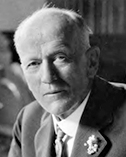Paleontologist Charles Walcott was president of the National Academy of Sciences from 1917 to 1923. He made large contributions to stratigraphy by linking fossils to particular layers of rock. His most important discovery was of the well preserved fossils located in the Burgess Shale of Canada that painted a picture of early life on Earth.
With no formal education, Walcott began his career in paleontology by discovering new dig sites and selling specimens to universities. He joined the US Geological Survey in 1879, eventually becoming its director in 1894. In 1902 he co-founded, with Andrew Carnegie, the Carnegie Institute of Washington in which he served in numerous committees and research positions. In addition, he was the Secretary of the Smithsonian Institute in 1907 and President of the American Association for the Advancement of Science in 1923.
Walcott served as president of the National Academy of Sciences during World War I. In this time there was a large expansion of the National Research Council, which he had co-founded. He served as the Vice-chairman of the National Research Council, Chairman of the Research Councils Military Committee, Chairman of the Executive Committee of the National Advisory Committee for Aeronautics, and other various wartime committees. In 1921 Walcott received the Mary Clark Thompson Medal from the National Academy of Sciences for his work in geology and paleontology. The Charles Doolittle Walcott award is presented by the National Academy of Sciences for excellence in research on pre-Cambrian and Cambrian life.



